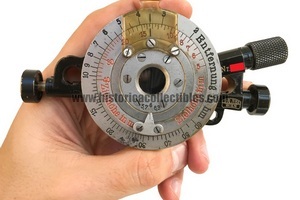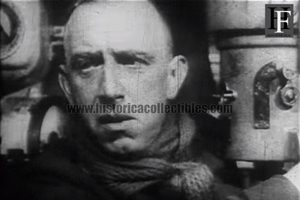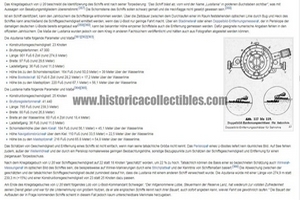Doppelbild-Entfernungsschätzer für Sehrohre, Kaiserliche Marine, circa 1915
Doppelbild-Entfernungsschätzer für Sehrohre or Double Image Rangefinder for Attack Periscope, made by Carl Zeiss Wien in 1915 and used on U-boats of the Kaiserliche Marine (Imperial German Navy) during the First World War. In 1913, the Kaiserliche Marine had its first U-boat built and at the beginning of the Great War the war potential rose to 30 combat-ready units.
This revolutionary kind of vessel, also called Submarine Boat or U-Boot, was not particularly powerful or very reliable and soon proved to be lacking in technology. The Officers placed in command in the context of the first war operations soon found it impossible to evaluate the correct determination of the calculations on the distances of the targets, due precisely to the absence of suitable devices suitable for this purpose.
Fearing that this deficiency could hinder and limit the execution of attack operations, the German U-boat Commanders attempted to develop some alternative strategies, also relying on their intuition and on all those distinctive elements that characterized them such as: visual acuity, decision-making ability and last but not least experience, thus defining a ruthless hunt for merchant convoys and passenger ships which, defenceless, could easily be torpedoed from close ranges without the aid of sophisticated devices.
Therefore the U-boat Commanders continued to attack and summarily destroy all those defenseless convoys which usually coming from America transported supplies to Europe, aware of the fact that these operations would have triggered an immediate and violent counter-offensive forcing them to fight the conflict in the in its entirety against large Allied combat naval forces.
With the emergence of these new events, the German commanders configured new strategies that were even more suited to the situation, trying to carry out the attacks while keeping from the targets at much higher distances even if, in these circumstances, carrying out surveys and measurements through the use of inadequate devices based on approximate or intuitive calculations, the U-boats and their crews would have been exposed to suffer dangerous and devastating counterattacks, therefore it was necessary as soon as possible to have the possibility of determining the calculations on the distances of the targets by means of an appropriate instrumentation through which to obtain the results with extreme precision.
To drastically respond to this now validated technological need, the Command of the Kaiserliche Marine ordered the company in charge to urgently create a suitable instrument that suited the specific requests, so it was designed and created solely by Carl Zeiss Wien, the "Doppelbild-Entfernungsschätzerfür Sehrohre" or double image distance estimator rangefinder for Attack, intended for the specific use of German U-boat Commanders starting from 1915.
Thanks to the ingenious creation of this device, which by means of two snap mechanisms was connected to the eyepiece of the U-boat's attack periscope, exact calculations of the angle distance on the target arc were made possible. Through four bifocal lenses and a towable prism, a second image was created which could be rotated by 90 degrees, when the moving image was at the same level as the primary image, it was positioned horizontally and superimposed correctly until it was acquired on the eyepiece of the periscope a single image. Finally, an indicator placed on the central dial highlighted the reading of the corner distance of the target on the two scales divided into meters and hectometers, after which hitting the target with the launch of torpedoes could be done with maximum precision.
The use of this device by the German Commanders in the countless war operations carried out during the First World War is known, which contributed to obtaining the favorable outcome of many battles by designating the U-boats as the most insidious and lethal means of war never made.
It is possible to state with considered certainty that an example identical to this Doppelbild-Entfernungsschätzer für Sehrohre, was used on the attack periscope of the U-boat U-20, which was commanded by Kapitänleutnant WaltherSchwieger between the beginning of 1915 and the end of 1916, resulted in the sinking of approximately 40 ships, including the English transatlantic "RMSLusitania" where over 1200 people perished.
Until now, the Doppelbild-Entfernungsschätzer für Sehrohre was known only through a copy of a paper document published at the time by Carl Zeiss Vienna, which, in addition to the real image of the instrument, described its technical characteristics. We currently believe that this specimen is the only one known to exist. Perfectly intact and functioning, in exceptional condition, with its original box marked Carl Zeiss Vienna.
Its intrinsic historical collectible value is irrefutable and occupied one of the prominent places among all the instruments used on board the U-boats during the First World War.
Carl Zeiss Jena purchased a factory located in the 14th District of Vienna west of the city in 1906 which became the first optical device manufacturing plant outside of Jena. All its production was under the "Carl Zeiss Wien" brand and remained active for only a few years, when at the end of the First World War the factory was completely abandoned.










